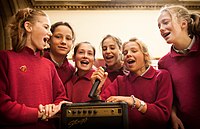
Photo from wikipedia
The high-level percussive sounds generated for seismic sea floor exploration have the potential to disrupt normal behaviors of whales. This study assesses if there is any reduction in the singing… Click to show full abstract
The high-level percussive sounds generated for seismic sea floor exploration have the potential to disrupt normal behaviors of whales. This study assesses if there is any reduction in the singing behaviour of migrating humpback whales in response to nearby airguns. Singing whales were acoustically tracked as they migrated along the coastline of south-eastern Queensland. A 20 cubic inch airgun or 140 cubic inch array of airguns was towed through the study area for 1 hour with the airguns firing every 11 sec (active treatments) or without the airguns operating (controls). Singing activity across each day was measured by counting the number of singing whales within the 10km-radius study area every 10 min, from 0700 to 1700, including during experiments. Singing activity during active periods and controls were compared with each other as well as with pseudo-randomly selected 1 hour periods when experiments were not underway (baseline). Changes in singing effort were also recorded by noting the number of instances of a singer stopping or starting during these periods. Preliminary analyses show no significant differences in singing activity, nor changes in singing effort, between active, control, or baseline periods.The high-level percussive sounds generated for seismic sea floor exploration have the potential to disrupt normal behaviors of whales. This study assesses if there is any reduction in the singing behaviour of migrating humpback whales in response to nearby airguns. Singing whales were acoustically tracked as they migrated along the coastline of south-eastern Queensland. A 20 cubic inch airgun or 140 cubic inch array of airguns was towed through the study area for 1 hour with the airguns firing every 11 sec (active treatments) or without the airguns operating (controls). Singing activity across each day was measured by counting the number of singing whales within the 10km-radius study area every 10 min, from 0700 to 1700, including during experiments. Singing activity during active periods and controls were compared with each other as well as with pseudo-randomly selected 1 hour periods when experiments were not underway (baseline). Changes in singing effort were also recorded by noting the number of insta...
Journal Title: Journal of the Acoustical Society of America
Year Published: 2018
Link to full text (if available)
Share on Social Media: Sign Up to like & get
recommendations!